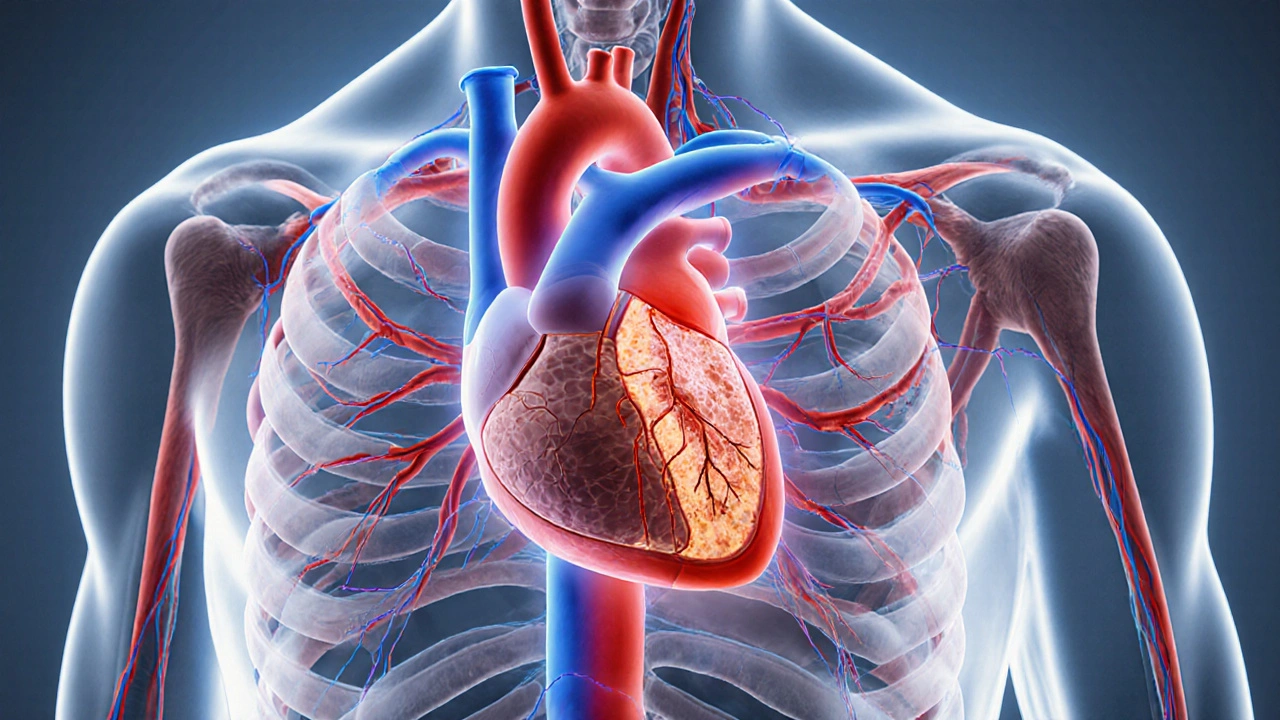Chest pain, pressure, or a squeezing sensation can feel terrifying, especially when you’re not sure what’s causing it. Angina is the medical term for that uncomfortable feeling, and it usually signals that the heart isn’t getting enough oxygen. Knowing the types of angina and spotting the warning signs can mean the difference between a routine check‑up and a life‑saving emergency.
What is Angina?
Angina describes chest discomfort that occurs when heart muscle (myocardium) temporarily receives less oxygen‑rich blood than it needs. The condition is most often linked to Coronary Artery Disease (CAD), a buildup of plaque that narrows the arteries feeding the heart. While anyone can experience angina, risk factors such as high blood pressure, smoking, diabetes, and a family history of heart disease raise the odds.
Main Types of Angina
Angina isn’t a one‑size‑fits‑all label. Clinicians sort it into several categories based on how it shows up, what provokes it, and how risky it is. Below are the four most commonly discussed types.
Stable Angina
Stable Angina is predictable chest pain that typically occurs during physical exertion or emotional stress and eases with rest or nitroglycerin. The pain usually lasts a few minutes and follows a consistent pattern-walk up a flight of stairs, feel the tightness, then stop and recover. Because it’s linked to a fixed narrowing of the coronary arteries, doctors often manage it with lifestyle changes, blood‑pressure medicines, and cholesterol‑lowering drugs.
Unstable Angina
Unstable Angina is an abrupt change in chest pain intensity, frequency, or duration, and it may occur at rest. This form is a red flag for an impending heart attack. The pain may linger longer than five minutes, be less predictable, or not respond to usual medication. Immediate medical evaluation is crucial because the underlying plaque is often rupturing, triggering blood clots.
Variant (Prinzmetal) Angina
Variant Angina, also called Prinzmetal Angina, occurs when a coronary artery spasms, temporarily narrowing the vessel even without significant plaque. The hallmark is pain that shows up at rest-often in the early morning-and is usually relieved by calcium‑channel blockers or nitrates. Stress triggers are less likely; instead, cold weather, smoking, or certain drugs can provoke the spasm.
Microvascular Angina
Microvascular Angina stems from dysfunction of the tiny blood vessels (microvasculature) that supply the heart muscle. Patients feel classic chest discomfort, but angiograms often look normal because the large coronary arteries aren’t blocked. Women are disproportionately affected, and diagnosis relies on stress testing, cardiac MRI, or coronary flow reserve measurements.
Side‑by‑Side Comparison
| Characteristic | Stable | Unstable | Variant (Prinzmetal) | Microvascular |
|---|---|---|---|---|
| Typical trigger | Exercise or emotional stress | Often at rest; sudden change in pattern | Rest (often early morning) | Physical exertion or emotional stress; vessels themselves are the issue |
| Duration of pain | Minutes, resolves with rest | 5+ minutes, may not fully resolve | Few minutes, often severe | Variable, can be prolonged |
| ECG findings | Transient ST‑depression during episode | ST‑depression or elevation, possible arrhythmias | Transient ST‑elevation during spasm | Often normal or subtle changes |
| Response to nitroglycerin | Usually rapid relief | May provide partial relief | Effective in most cases | Variable effectiveness |
| Long‑term risk | Elevated but manageable | High risk of heart attack | Risk of recurrent spasms | Risk of chronic heart pain, reduced quality of life |

How to Recognize Angina Symptoms
Even though chest pain is the classic sign, angina can masquerade in many ways. Keep an eye out for these patterns, and ask yourself whether they fit the profile of any type discussed above.
- Location: Pressure, squeezing, burning, or a heavy weight typically felt behind the breastbone. Pain may radiate to the left arm, jaw, neck, back, or even the stomach.
- Onset: Stable angina builds gradually with activity; unstable angina can strike suddenly, even at rest.
- Duration: If the discomfort lasts more than 5 minutes or doesn’t fully subside with rest, treat it as a warning sign.
- Associated symptoms: Shortness of breath, nausea, cold sweats, or light‑headedness often accompany the chest discomfort.
- Trigger differences: Variant angina commonly appears at night or early morning, whereas microvascular angina may feel more like fatigue or vague chest tightness.
When you notice any of these clues, especially if they’re new or changing, it’s time to act.
When to Seek Immediate Medical Help
Because angina can be a prelude to a heart attack, err on the side of caution. Call emergency services (9‑1‑1 in the U.S.) if you experience:
- Pain that lasts longer than 5minutes despite rest or medication.
- Sudden, severe chest pressure that radiates to the arm, jaw, or back.
- Shortness of breath, fainting, or a feeling of impending doom.
- New or worsening symptoms compared with your typical pattern.
Even if the pain eases, getting evaluated helps rule out an evolving heart attack.

Initial Management and Prevention Tips
While waiting for medical help-or if you’ve been diagnosed with stable or microvascular angina-these steps can reduce episodes.
- Medication adherence: Nitroglycerin tablets or sprays, beta‑blockers, and long‑acting nitrates are mainstays for stable angina. Calcium‑channel blockers work well for variant angina.
- Know your triggers: Keep a simple diary noting activities, stress levels, weather, and food intake before an episode. Over time you’ll spot patterns you can avoid.
- Lifestyle changes: Quit smoking, adopt a Mediterranean‑style diet, aim for 150minutes of moderate exercise weekly, and keep blood pressure and cholesterol in check.
- Stress management: Mindfulness, yoga, or short breathing exercises can blunt the adrenaline surge that often precipitates stable angina.
- Regular check‑ups: Annual stress tests, lipid panels, and blood‑pressure monitoring catch worsening disease early.
For those with unstable or variant angina, doctors may recommend more aggressive interventions like angioplasty, stent placement, or even coronary artery bypass grafting (CABG) depending on the severity.
Quick Takeaways
- Angina is chest pain caused by reduced oxygen to the heart muscle.
- Four core types-stable, unstable, variant (Prinzmetal), and microvascular-differ in triggers, duration, and risk level.
- Unusual, prolonged, or resting chest pain should be treated as an emergency.
- Medication, lifestyle tweaks, and regular monitoring keep stable angina under control.
- Understanding your own symptom pattern is the best defense against a heart attack.
Frequently Asked Questions
Can women have angina without obvious artery blockage?
Yes. Women are more likely to develop Microvascular Angina, where the small vessels don’t dilate properly. Standard angiograms may look normal, so doctors use stress imaging or coronary flow reserve tests to confirm the diagnosis.
Is chest pain always a sign of angina?
No. Chest discomfort can stem from acid reflux, musculoskeletal strain, anxiety, or lung conditions. However, any new or unexplained chest pain warrants evaluation because angina is a serious possibility.
How does an Electrocardiogram help differentiate angina types?
During stable angina, a stress ECG may show temporary ST‑depression. Unstable angina often produces persistent ST‑depression or even elevation, indicating more severe myocardial ischemia. Variant angina characteristically causes brief ST‑elevation when the artery spasms.
Can lifestyle changes eliminate the need for medication?
In some cases of mild stable angina, aggressive diet, exercise, and smoking cessation can reduce the frequency of episodes enough to lower medication doses. However, most patients still need at least one heart‑protective drug, so never stop medication without a doctor’s guidance.
What is the role of nitroglycerin in managing angina?
Nitroglycerin quickly dilates coronary arteries, improving blood flow and relieving chest pain within minutes. It works best for stable and variant angina. For unstable angina, nitroglycerin may provide partial relief, but emergency care is still required.

Comments (10)
Liam Davis
October 8, 2025 AT 20:43
When it comes to angina, the variety can feel overwhelming, but each type has its own story.
Stable angina, for example, tends to follow a predictable pattern, showing up during a brisk walk or a stressful deadline and fading when you pause.
Unstable angina, on the other hand, throws a curveball by appearing at rest and lingering longer than usual, signaling that the underlying plaque might be rupturing.
Variant, also known as Prinzmetal, is a bit of a trickster because it loves to strike in the early morning hours when the arteries suddenly spasm.
Microvascular angina hides in the small vessels, often leaving the big arteries looking clean on an angiogram while the patient still feels the pressure.
The good news is that lifestyle tweaks-like quitting smoking, adding leafy greens, and aiming for 150 minutes of moderate activity each week-can blunt many episodes.
Medications such as nitroglycerin work quickly by widening the coronary vessels, giving relief within minutes for most patients.
For those with variant angina, calcium‑channel blockers are the go‑to because they keep the spasm at bay.
In the case of microvascular angina, doctors may rely on stress imaging or cardiac MRI to uncover the issue, since a plain‑vanilla stress test can miss it.
Keeping a simple diary of what you were doing, feeling, and the weather before an episode can reveal hidden triggers that you can then avoid.
Remember that chest discomfort isn’t always heart‑related; acid reflux or muscle strain can mimic angina, so a thorough work‑up is essential.
If you ever notice pain lasting more than five minutes despite rest or nitroglycerin, treat it as an emergency and call 911.
Early intervention not only saves lives but also reduces the long‑term damage that repeated episodes can cause.
Talk to your cardiologist about a personalized plan that may include beta‑blockers, statins, or even revascularization procedures if the risk is high.
Staying informed and listening to your body’s signals empowers you to act before a small warning turns into a big problem.
Take care of yourself, stay proactive, and don’t hesitate to reach out for help when you need it :)
Arlene January
October 15, 2025 AT 19:23
Having seen many people grapple with heart symptoms, I think staying motivated is key.
A quick habit-like a 5‑minute breathing exercise before a stressful meeting-can keep the chest tightness at bay.
Pairing that with a daily walk, even if it’s just around the block, builds stamina without over‑exerting the heart.
Celebrate each small win, because those wins add up to big health gains over time!
Keep that energy up and you’ll notice the angina episodes becoming less frequent.
Kaitlyn Duran
October 22, 2025 AT 18:03
I’ve been curious about how nighttime spasm patterns differ across age groups.
Terri DeLuca-MacMahon
October 29, 2025 AT 16:43
When you break down the four angina types, the picture becomes a lot less scary.
Stable angina follows a schedule, so you can plan your activities around it 😊.
Unstable angina is the red‑flag that needs immediate attention, no excuses 💥.
Variant angina loves the early morning chill, which is why a warm coat can actually help prevent a spasm 🧥.
Microvascular angina may hide in women more often, so listening to subtle chest tightness is crucial 🙌.
gary kennemer
November 5, 2025 AT 15:23
Reflecting on that breakdown, I see a philosophical angle to how we respond to bodily signals.
The heart, after all, is a rhythmic teacher, reminding us when we push too hard or ignore subtle cues.
Stable angina can be viewed as a scheduled lesson-warn us, then give us a chance to adjust.
Unstable angina, meanwhile, shouts that the current path is unsustainable, urging a rapid shift.
Variant angina’s early‑morning spasms suggest that even our internal environment-temperature, stress-plays a role in health.
Microvascular angina invites us to look beyond the obvious arteries and consider the intricate web that sustains life.
By honoring these signals, we cultivate a deeper respect for our own mortality and agency.
In practice, this means integrating mindful breathing, regular movement, and attentive medical follow‑up.
Payton Haynes
November 12, 2025 AT 14:03
What the pharma industry doesn’t want you to know is that many pills mask the real problem.
They push nitroglycerin while ignoring diet, stress, and hidden chemicals in water.
The real fix is to clean up what you eat and avoid the smoke that pollutes the air.
Trust your body more than the big companies that profit from chronic pain.
Earlene Kalman
November 19, 2025 AT 12:43
Your take is naive and ignores years of clinical data.
Medicine has proven that nitroglycerin saves lives in acute episodes.
Dismissing it as a scam shows a lack of basic understanding.
Brian Skehan
November 26, 2025 AT 11:23
I’ve seen the hidden agenda behind heart health guidelines.
The numbers are often twisted to keep drug sales high, and the lifestyle advice is watered down.
Real independence comes from using natural diets and getting regular movement without relying on costly prescriptions.
Stay alert and question the sources that tell you what’s best.
Andrew J. Zak
December 3, 2025 AT 10:03
It's wise to stay open minded and check many sources.
A balanced approach that mixes good food exercise and regular check ups works best.
Dominique Watson
December 10, 2025 AT 08:43
In the context of our national health policies, it is essential to recognise the impact of cardiovascular disease.
The United Kingdom must invest in preventive cardiology to reduce the burden on the NHS.
Encouraging public awareness of angina types and early intervention aligns with our commitment to a healthier citizenry.
Such measures will strengthen the nation’s productivity and safeguard future generations.